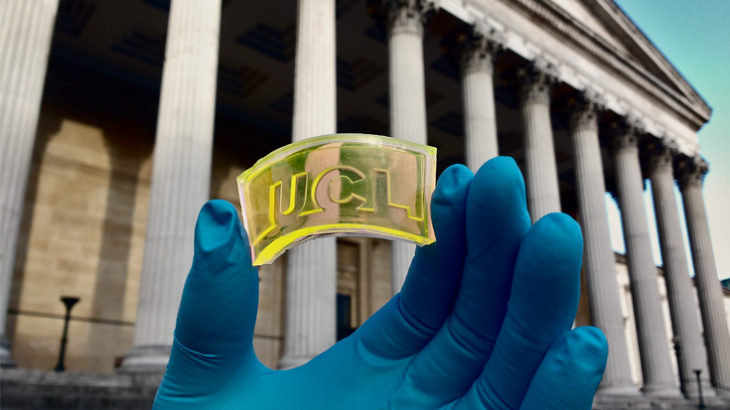Innovative Doctoral Training Comes To Light

The science of light is the focus of a joint UCL-Cambridge University centre turning today’s PhD students into tomorrow’s industry innovators – and equipping them to propel a vital growth sector forward into a future full of possibilities.
Combining dynamism and invention with opportunities hugely enriched by its cross-institutional nature, the Centre for Doctoral Training (CDT) in Integrated Photonic and Electronic Systems (IPES) has created an open, ‘can do’ research community that, through its leading-edge work, is helping to transform the way we live, work, play and communicate.
Strengthened by extensive ties with industry and business, the Centre’s success in linking the capabilities of two leading universities – reflected in the phenomenal breadth of research it offers students – has established it as a genuine world-leader in its field.
A Shared Vision
Generating light, detecting it, manipulating it, harnessing it for communications, data transfer and much more besides – these are the key elements of photonics, a branch of science impacting on everything from lasers, lighting and medical imaging to biometric security and advanced robotics. Over the last half-century, it has blossomed into a trillion-dollar global market that still offers staggering potential for further growth and innovation.
In 2009, funded by the Engineering and Physical Sciences Research Council (EPSRC) and with a brief to provide the skills needed to keep the sector surging forward, the UCL-Cambridge CDT in Photonics Systems Development first opened its doors. Four years later – responding to growing demand for expertise spanning photonic and electronic systems – it extended its scope to even more research groups at the two institutions and became the CDT in IPES.
“The CDT in IPES has successfully established an extensive two-way network that spans academia and industry”
Dr Cyril Renaud, Associate Director, CDT in IPES
“Every year, we welcome around 20 talented students onto our 4-year training programme” says Dr Cyril Renaud, Assistant Director. “They’re attracted by the strong vision established by UCL and Cambridge right from the outset. Cutting-edge research addressing current and future challenges to deliver new devices, novel systems and next-generation technologies; recognition of the power and value of collaboration; determination to remain industry-relevant – these lie at the heart of what we offer our close-knit community of students.”
At The Centre Of Collaboration And Innovation
The Centre’s research addresses seven broad areas: materials, devices, biomedical applications, displays & imaging, telecommunications, Terahertz technologies, and other photonics applications. Above all, in terms of the insights it generates and the education it provides, it is the Centre’s collaborative, innovative character that maximises its impact:
- Developing masters of research: Before starting their PhD, students complete an intensive 1-year Master of Research (MRes) course taught across both institutions. This provides a chance to develop a broader foundation of skills as well as to identify a PhD topic closely aligned with their interests. “The MRes is a powerful innovation,” says Dr Ioannis Papakonstantinou of UCL. “Alongside structured teaching, students undertake two research projects: one at their home institution and one at the other, or with industry.”
- Delivering joint supervision: Joint supervision across the two institutions is a key feature, not only expanding the students’ horizons but also strengthening the skills they bring to research teams. “Two students in my Electronic and Photonic Nanomaterials group here at Cambridge are from the Centre and I jointly supervise one of them with Ioannis,” says Dr Hannah Joyce. “As a young researcher myself, this pool of talent is vital to my ability to build a top-class team that can, for instance, develop nanomaterials for use in a range of devices incorporating optoelectronics, or electronics that work by harnessing light.”
- Sharing expertise & equipment: Collaboration is built into the fabric of the Centre, with students attending monthly seminars to meet each other and foster relationships. Combining capabilities pays dividends in very practical ways too. “In the field of innovative solar cells, for example, students can develop models of devices using UCL’s computational resources and then build them using Cambridge’s fabrication facilities,” says Dr Papakonstantinou. Nor should wider spin-off benefits be underestimated. “The Centre has really catalysed close co-operation between Ioannis’s team and my team in the development of flexible solar cells that can be attached to clothes and non-flat surfaces,” notes Dr Joyce.
- Widening academic choice: One great benefit of the Centre’s cross-institutional character and extensive links with industry is the sheer breadth of research topics it offers. “Within the MRes framework alone, there are around 70 to 80 projects available, covering the full research spectrum from fundamental to applied,” Dr Papakonstantinou explains. “In all, the Centre’s students have access to around 60 supervisors across Cambridge, UCL and industry.”
Leading Lights In Industry
Ultimately, the Centre’s impact is judged by its ability to provide the photonics industry with the world-class engineers and scientists it needs in order to succeed. Industrial engagement is a critical element in everything the Centre does, with industrial representation on its Board of Directors, regular Industry Open Days and the involvement of companies in shaping PhDs and providing students with all kinds of fantastic opportunities:
- Secondments to global players, such as Hitachi and Toshiba in Japan or CERN (the European Organisation for Nuclear Research) in Switzerland, are a core element.
- Small and Medium-sized Enterprises (SMEs) also make a key contribution – SMEs like Penteract28, a start-up specialising in shrinking big data using digital holography.
“This pool of talent is vital to my ability to build a top-class team in electronic and photonic nanomaterials”
Dr Hannah Joyce, University Lecturer, University of Cambridge
“We’ve already taken four of the Centre’s students on summer placements to work on specific mini-research projects”, says Darran Milne, Penteract28’s Head of Research. “As well as providing them with brilliant experience, this mechanism has enabled us to tap quickly into the right resources to get us over the awkward start-up phase. We’ve been really impressed by the students’ work ethic, independent working and ability to come up with good ideas.”
Dr Renaud comments: “The CDT in IPES has successfully established an extensive two-way network that spans academia and industry. As well as working with businesses to develop the technologies of tomorrow while they’re with us, our students go on to take up important positions in industry and many of them later come back to share their experiences – inspiring our students to take the skills they develop here and make a real difference to a sector whose potential knows no bounds.”
Further Information
Click here for an extensive list of academic publications in high-impact journals by current, former and associated CDT in IPES students.
- CDT in IPES
- UCL Department of Electronic & Electrical Engineering
- Cambridge University Department of Engineering
- How to make light work implementing your technology strategy
- Integrated photonic systems are expected to drive the development of new applications, including Ultra HD broadcast
- Let us help you be the best, too
Contacts

Dr Ioannis Papakonstantinou
Dr Hannah Joyce


